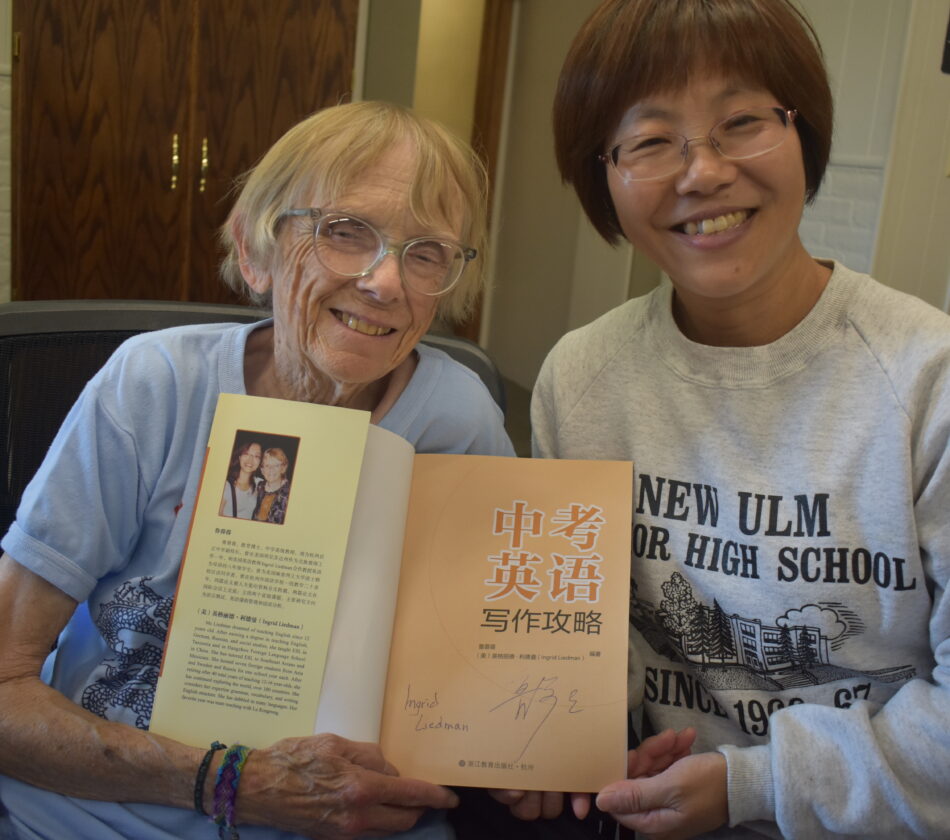By the book friendship
A collaboration 30 years in the making

English teachers and longtime friends, Ingrid Liedman (left) and Ms Lu (right) hold open a copy of their recently published book to the title page. The English translation of the book’s title is “Writing Strategies for English High School Entrance Examination.”
NEW ULM – In 1994, Ingrid Liedman, an English teacher with New Ulm Public, spent six months teaching at the Hangzhou Foreign Language School (HFLS) in China. There she met fellow English teacher Lu Rongrong. The two have maintained a friendship for over three decades and have recently collaborated on a book to help Chinese students with English language entrance exams.
Liedman said her friendship with Lu Rongrong Lu, who goes by the name Ms Lu, began thanks to a deal between HFLS and the Minnesota Department of Education. The deal allowed English teachers in the United States to apply for teaching positions in China. Liedman’s application was accepted, and for six months in 1994, she was able to work at HFLS. During that half year she shared an office with Lu, who was a first-year teacher.
Liedman said that since Lu was new to teaching and she was new to teaching in China, the two quickly became close.
After her half year at HFLS, Liedman learned that China had a program to allow their English teachers to come work in the United States for a year. Liedman offered to help sponsor Lu if she was willing to teach in New Ulm for a year. Seven years later, Lu took up Liedman’s offer. During the 2001-02 school year, Liedman and Lu taught English to the eighth grade at New Ulm Middle School as a team.
Lu said teaching English in New Ulm was a challenge. It required a lot of study, but by the end of the year, she was providing instruction on novels as well as vocabulary.
During Lu’s stay in New Ulm, she was hosted by four different local families, which also helped her learn about different aspects of American culture.
Lu was also able to pass on aspects of Chinese culture. She remembers teaching the students Chinese stories, such as the legend of the Monkey King, but also unique exercises. Lu said there is a special eye exercise that Chinese students participate in as a class. This exercise is designed to protect eyesight.
Liedman said she witnessed these eye exercises being conducted when she taught in China and acknowledged it was culture shock, but it was valuable insight.
“Those kinds of things are the real value of having a long-term exchange,” Liedman said. She believed a six-month or year visit helps see people in their normal life and leads to more in depth and authentic understandings.
The two teacher agreed they both benefit from the exchange and their 30-year friendship. It was on the 30th anniversary of their friendship that the two completed their book design to benefit English language learners in China.
The direct English translation of their book’s title is “Writing Strategies for English High School Entrance Examination.”
Lu said she came up with the idea for the book after seeing many Chinese students struggle to speak authentic English.
“The Chinese-English learners do not have a large vocabulary,” Lu said. “In writing, they do not pick the correct words and are not familiar with the authentic English expressions.”
The other challenge was that many Chinese students did not have access to native English speakers. Most of their knowledge of the English language came from memorization.
“These kids would come to the office having memorized a half-page. They would stand like a soldier and spout it out to get an OK from the teacher, but there was no emotion behind it,” Liedman said. “Now, when you teach English, it is more conversational and more workable.”
In order for Chinese students to attend the HFLS or any other English language school, they must first pass an English exam
“The higher score they get, the better school they can get into,” Lu said. If the students cannot write authentic English essays, they are at a disadvantage. Liedman and Lu’s book is designed to help students craft authentic essays for the exam.
The book is split into four sections. Each section features a different type of English writing prompt. The first prompt is responding to an email. The second is writing a newspaper editorial. The third is drafting a speech for an oral report. The fourth is an essay on decision-making.
For each section, several examples of real student submissions for the prompts are given in English. For each writing sample, Liedman and Lu provided feedback and commentary. The idea is to show by example the difference between literal Chinese to English translations and authentic English.
Liedman said some of her critiques in the book were factual. Besides checking grammar and sentence structure, she also made sure the students used correct phrases. In one example, a student wrote “such a strong feeling of joy,” but Liedman suggested using “filled with joy” instead.
Liedman said she wanted her critiques and commentary to help students stand out from the crowd. She wanted the essays to feature creativity and imagination instead of conforming to a standard.
The book was officially published in February of 2024 and has proven to be a great success. Lu confirmed that the first edition of the book has sold out in China.
“This book is quite popular,” she said. “The publisher is looking forward to having a second edition from us.”
Liedman and Lu are both excited that their collaboration has proven to be a success. The book has proven to be a fitting way to honor a 30-year friendship that continues to cross boarders and culture.





